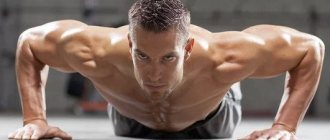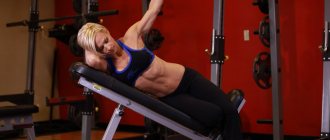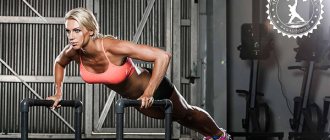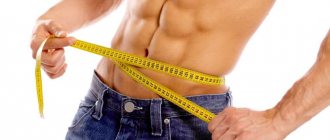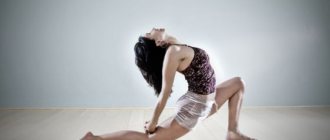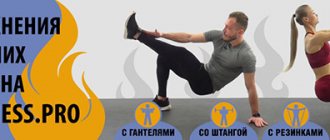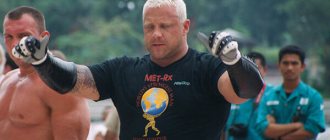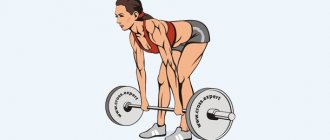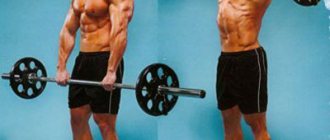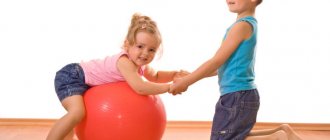In training activities, what is important is not the modernity of the simulators used, but the magnitude and systematicity of the load exerted on the muscles.
In this regard, barbell plates are the best equipment for working out the muscle groups of the body. This article will discuss the essence and benefits of performing exercises with pancakes, the technique of performing them, as well as special training programs.
- The essence and benefits of exercises with a pancake
- Technique for performing abdominal exercises
- On shoulders
- On the chest
- In your arms
- "Bus driver"
The essence and benefits of exercises with a pancake
Holding the weight plate increases the load placed on the body during training. The deep core stabilizing muscles, which are responsible for maintaining balance, are involved in completing tasks.
The weight of the pancakes can be regularly increased, thereby achieving better training results. At the same time, the body's endurance increases, the layer of subcutaneous fat is burned, the body becomes more toned and sculpted.
Important! Train with plates no more than four times a week, and devote the rest of the time to cardio training and aerobics. Performing various types of exercises will not only strengthen the body, but also get rid of excess fat tissue.
Regardless of which part of the body is worked with a pancake, the load is placed on the entire body - different muscle groups are constantly involved in the training process.
What muscles work
Movement is provided by:
- Large and medium gluteals;
- Biceps and quadriceps thighs;
- Soleus muscles.
Stabilize the body:
- Rectus abdominis muscle;
- Long back muscles;
- Partly - the latissimus dorsi muscles.
Work statically while holding weight:
- Deltoids and trapezoids;
- Biceps;
- Forearms.
The goblet squat involves a lot of muscles, which is why it is often found in “metabolic” training and weight loss programs. Compared to the standard “physical training” option without weights, calorie consumption will be higher.
Exercise technique
There are a large number of training complexes designed for different parts of the body.
Check out full body exercise routines with: medicine ball, stability ball, hula hoop, kettlebells, elastic band and resistance spring.
On the press
Exercises must be performed with the maximum bearable load for six to eight repetitions. It is this method, and not extremely long-term pumping, that increases muscle mass and strength.
- Get down on the floor, lie straight and bend your knees. Place the plate on your lower abdomen and support it with your hands. Smoothly lift your pelvis off the floor and lift it so that your body forms a straight line with your hips. Return to the starting position. This exercise is called a weighted glute bridge.
- Lie on the floor, extend your arms with the apparatus above your head and pull your feet towards your pelvis. Using only your abdominal muscles (without straining your shoulder girdle), lift your head, neck and shoulders above the floor. Smoothly lower yourself to the starting position. Perform 8 repetitions.
- Lie down on the mats, take the plate in your hands and touch it to your body. Move your feet towards your pelvis. Now lift your body while turning it to the side until the plate pressed against it touches your hips. Smoothly return to the starting position and twist in the other direction. Do four reps on each side.
- Place a light weight projectile on your lower back, gently bend down and place your palms on the floor. Walk them forward until you are in a plank position. Stay in this position for 30 seconds. Do push-ups if desired. The number of repetitions is up to seven times.
On shoulders
Perform the following exercises carefully to avoid damaging your shoulder joints.
- Stand straight, place your feet at a distance of 45 cm from each other.
Take the pancake and smoothly lift it with outstretched arms to chest level. Lower it to the starting position. Do eight repetitions. Did you know? Pullovers are considered one of the most popular strength exercises. The Russian circus wrestler of the early 20th century, Karl Hackenschmidt, introduced this exercise into everyday use and became famous largely thanks to it. He stood on the wrestling bridge, picked up a barbell and pressed it, and then pulled it behind his head. Just being in the pullover position is very difficult for the average person, but Hackenschmidt was so strong that he could press a barbell weighing more than 140 kg from this position. - Stand up straight, take the projectile in your hands and place your hands behind your head. Now, on the count of “one,” raise it above your head, and on the count of “two,” lower it to the previous position. Take a second break and repeat the sequence. The number of repetitions is eight.
- Lower yourself into a half-squat, slightly tilt your body. Hold the pancake in front of you with your arms bent. Bring the plate closer to your body and then return to the starting position.
- Lie down lengthwise on a low bench with your feet on either side of the bench. Take the projectile, place it on your forehead and hold it with your hands. Raise your upper shoulder girdle until your shoulder blades lift off the bench. Return to the starting position. Six repetitions will be enough. This exercise can be varied by lifting the pelvis - in this case the pancake is placed on it.
Video: shoulder exercises with a barbell plate
On the chest
To avoid tearing your pectoral muscles, start training with light weights (up to 5 kg). Increase it by 2-3 kg weekly.
- Stand up straight, pick up a plate and fix it in front of your body with bent arms. Describe them a circular path clockwise - to the shoulder, over the head, over the other shoulder and back to the chest. Describe the circle in the other direction. Perform two sets of five times.
- Lower the pancake to the floor and place a horizontal emphasis on it. Jump yourself into a squatting position, grab the plate and rise up with it. Pull the projectile over your head, lower it to the floor and repeat the sequence. This is a complicated burpee that should be performed no more than five times in one approach.
- Squat down, spread your knees wide. Cover the disc with your palms, lower it between your knees so that it almost lies on the floor, then bring it to your chest with half-bent arms. Do 10 repetitions.
- Stand straight, place your feet at a distance of 45 cm. Take a pancake in your hands and do a squat. Now bend your elbows, then moving the pancake away from the body, then bringing it back. Perform two sets of seven times.
- Stand straight, spread your legs 45–50 cm wide. With a pancake in your palms, squat down, and then push yourself up with a strong movement. Smoothly return to the starting position and perform six repetitions.
In your arms
These are some of the simplest exercises that allow for a high number of repetitions.
- Take the disc in your hands and hold it in front of you for half a minute. Then lift it above your head and stay in this pose for another minute.
- Lie on the bench with your shoulder blades, bend your legs at an angle of 90 degrees and focus on them. Take the projectile in your palms, smoothly move it with outstretched arms from the body above your head to the shoulders and return to the previous position. This exercise is called a “pullover” and is performed in two sets of seven times.
- Stand straight, look ahead. Raise the projectile to chest level and describe a small circle with it in the air. Press the apparatus to your chest, rest for 2-3 seconds, repeat the exercise. The maximum number of approaches is 20.
- Press the projectile against the body. Bend over with it so that your body is parallel to the floor, and at the same time take one of your legs back. Touch the plate to the floor and return to the starting position. Do 10–15 reps.
- Place your feet 50cm apart. Bend your knees, tilting your body 45 degrees. With half-bent arms, hold the pancake in front of your stomach and lift it to your shoulder with a small swing. Lower the projectile back down and swing it to the other shoulder. Perform 15–20 swings.
Video: exercises with a barbell plate
Why does the inner part of the breast lag behind?
The human muscular frame is determined genetically. We have all probably noticed that some people have well-developed legs, while others, for example, have well-developed backs. The same goes for the pectoral muscles. For some, the chest muscles are naturally dense and evenly developed, while for others they are far behind.
Genetics is the main cause of weak breasts.
A secondary reason is poor training. For example, an athlete constantly does only dips and nothing else. This exercise develops the lower part of the chest (“edges”) well. As a result, such an “athlete” will receive good triceps, and in addition unevenly developed pectoral muscles with a lagging center.
We invite you to familiarize yourself with hand exercises for women photos
Training program
These programs train not only muscle strength, but also their endurance, as they were developed by MMA fighters.
Important! Don't stop during the exercise to catch your breath. If you feel like you're running out of energy, finish the set and give yourself five minutes of rest while doing light exercises.
"Bus driver"
Take the projectile and extend it in front of you with straight arms. Now rotate it in one direction or the other, using only the strength of your arms and shoulders. Perform two sets of 30 seconds - this will be enough to load the muscles that stabilize the shoulders.
"Around the world"
Stand straight, bring your shoulder blades together. Raise the projectile above your head with slightly bent arms and describe it in a circle as wide as possible. This program strengthens your core and shoulders and greatly fatigues your muscles. Do two sets of seven rotations.
Hyperextension
This is the best exercise for back straighteners
The hamstrings are also involved. This exercise is usually performed in a machine that can be easily installed at home, but even in the absence of this machine, it is easy to do hyperextensions at home.
You need to lie stomach down on a sofa or any other surface so that an assistant holds your legs on it and your torso calmly bends down. Without bending your back, you lower your body and slowly raise it back up.
Reverse hyperextensions can be performed on the floor, lying on your stomach, bending will occur in the opposite direction, upward.
With enough experience, you can use weights, do these exercises with dumbbells or a weight plate in your hands. You should perform 4 sets of 8-10 repetitions.
This exercise is much less traumatic than the deadlift and uses the same muscle groups.
Additional Tips
To make your workouts as effective as possible, follow the following rules for working with a weight plate:
- Start training with a light weight (up to 5 kg) and gradually increase the load based on how you feel.
- Always train in comfortable sneakers with non-slip soles - this will reduce injuries.
- Take breaks between exercises for 3-4 minutes so that the muscles have time to recover and do not become covered with micro-tears.
- When you perform exercises with lifting a plate, lift it using the deadlift method - this will help you avoid injuring your spine.
- Try to arrange the exercises so that the total duration of the workout does not exceed 20 minutes. Spend these 20 minutes as intensely as possible.
- If you plan to work on strength, do up to ten repetitions with maximum weight. If you are interested in muscle size, pump it up with minimal weight and a high number of sets and reps.
Video: Exercises with a barbell plate Plates exercises are used by a large number of professional athletes and wrestlers. They help build muscle mass, increase strength and help define muscle definition by burning subcutaneous fat.
Did you know? The origins of strength training is the American inventor and athlete Arthur Jones. It is to him that bodybuilding and strength training owe their phenomenal popularity at the end of the 20th century. In the 1970s, he released a pioneering line of strength training machines and pioneered the idea of short, maximum-impact training.
Follow the exercise technique strictly to get maximum benefit from it.
Exercises Sports and fitness Strength training Sports equipment
How to choose dumbbells for home
There are two types of design:
- prefabricated;
- solid cast.
A common mistake when buying dumbbells for home use is to buy non-separable light weight dumbbells and hope that they will last a long time. However, girls who intend to seriously engage in sports will quickly notice that two kilograms of weight is not enough for training. After just two weeks of regular training, you will have to go get new equipment.
Prefabricated dumbbells consist of plates of different weights and a bar. It is best to purchase several pancakes of different weights. Among them there should be both small ones, 0.5–1 kg, and larger pancakes: 5 and 10 kg. The more pancakes of different weights you buy, the more evenly you can increase your weight. Do not forget that there should be four plates of each weight: on both sides of each of the two dumbbells. The best option for purchasing pancakes looks like this:
- 0.5 kg – 4 discs;
- 2 kg – 8 discs;
- 1 kg – 4 discs;
- 5 kg – 4 discs.
When choosing a bar, you need to choose a standard diameter so that most of the pancakes on sale fit it. Try on the length of the bar so that training does not cause discomfort. To do this, you can perform several exercises right in the store. For convenience, you can purchase a bar with a corrugated or rubberized surface. Ask the seller what the weight of the bar is - this will help distribute the load better.
Articulation gymnastics “tea party”
We drink tea with sweets, pancakes, jam, sweet straws, and blow on tea.
- pancake - cup (we place a wide tongue on the lip, then wrap the tip in the shape of a cup)
- calyx - tube (we fold the tongue either into a tube or into a cup)
- candy - cup (we suck the tip of the tongue to the upper lip - cup)
- honey - calyx (tongue “stuck" to the upper lip - calyx)
- jam - a cup (we lick the upper lip from top to bottom, then left and right)
- cup - toffee (I in the shape of H rises up by the teeth, as if it wants to remove the glued toffee (chewing gum) from there)
- blow on tea - a cup (tapped the lip “five-five-five”, blew on tea, drank a cup)
After the child has learned to hold the Ch well, and also easily move into a tube and raise it like a “sail,” then it is quite possible to move on to the production of the upper sounds: D - T, hissing, sonors. Add breathing exercises that help you practice the direction of the blown air stream strictly in the middle. I will tell you about this in separate articles on setting R, Sh and breathing exercises.
And this is where I end this article, write your questions and comments in the comments. Share your impressions on social networks with friends and acquaintances.
